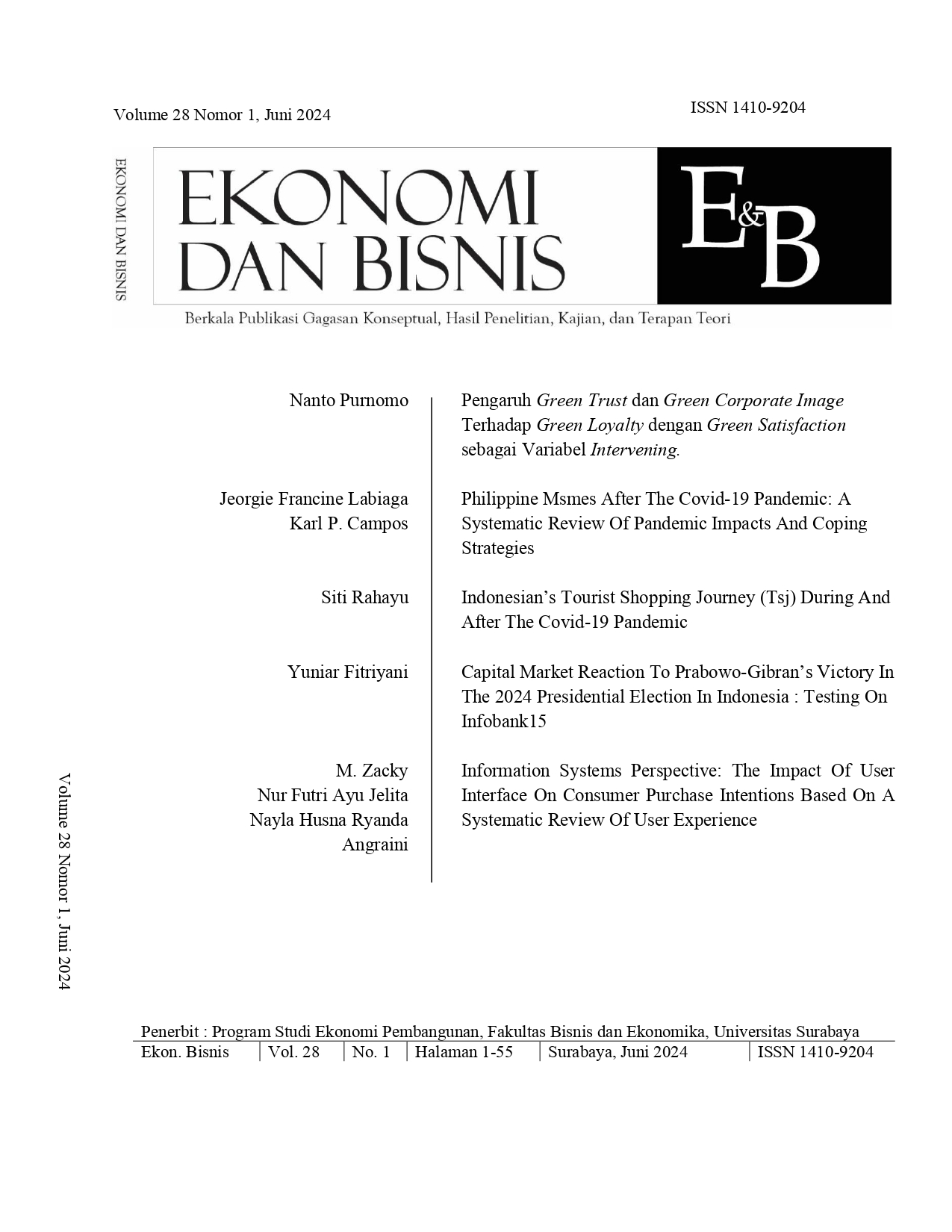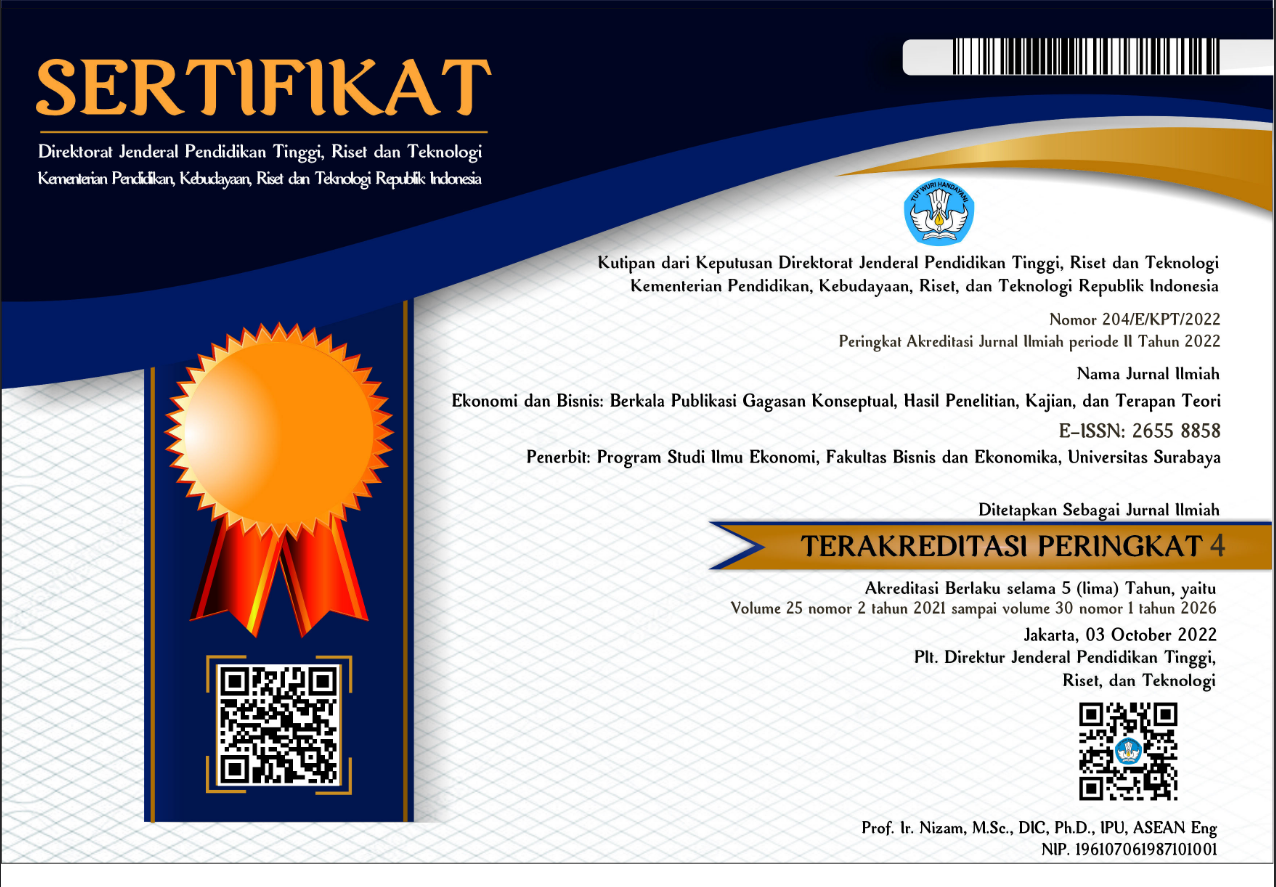INDONESIAN’S TOURIST SHOPPING JOURNEY (TSJ) DURING AND AFTER THE COVID-19 PANDEMIC
 Abstract Views:
354 times
Abstract Views:
354 times
 PDF Downloads:
182 times
PDF Downloads:
182 times
Abstract
This study aims to determine the effect of performance expectancy, effort expectancy, social influence, facilitating condition, pleasure, and arousal on the intention to use smartphones on the Tourist Shopping Journey (TSJ) on domestic tourists in Indonesia. There are two conditions in this study, namely during the Covid-19 pandemic and after. Data processing in this study used SPSS 24.0 and AMOS 24.0. The results showed that during the Covid-19 pandemic, the variables of facilitating condition and pleasure affected the intention to use smartphones when shopping on tourist trips. Meanwhile, in conditions after the Covid-19 pandemic, the influential variables are facilitating conditions and arousal.
Downloads
References
Bieger, T., & Laesser, C. (2004). Information sources for travel decisions: Toward a source process model. Journal of Travel Research, 42(4), 357–371. https://doi.org/10.1177/0047287504263030
Choi, M. (2018). International Journal of Contemporary Hospitality Management. The Eletronic Library, 7(411), 397–412.
Coromina, L., & Camprubí, R. (2016). Analysis of tourism information sources using a Mokken Scale perspective. Tourism Management, 56, 75–84. https://doi.org/10.1016/j.tourman.2016.03.025
Davis, F. D. (1985). A technology acceptance model for empirically testing new end-user information systems: Theory and results. Management, Ph.D.(January 1985), 291. https://doi.org/oclc/56932490
Dey, B., & Sarma, M. K. (2010). Information source usage among motive-based segments of travelers to newly emerging tourist destinations. Tourism Management, 31(3), 341–344. https://doi.org/10.1016/j.tourman.2009.03.015
Firdaus, F., Zulfadilla, Z., & Caniago, F. (2021). Research Methodology : Types in the New Perspective. Manazhim, 3(1), 1–16. https://doi.org/10.36088/manazhim.v3i1.903
Fuentes, C., & Svingstedt, A. (2017). Mobile shopping and the practice of shopping: A study of how young adults use smartphones to shop. Journal of Retailing and Consumer Services, 38(May), 137–146. https://doi.org/10.1016/j.jretconser.2017.06.002
García-Milon, A., Juaneda-Ayensa, E., Olarte-Pascual, C., & Pelegrín-Borondo, J. (2019). Tourist shopping and omnichanneling. Multilevel Approach to Competitiveness in the Global Tourism Industry, October, 87–97. https://doi.org/10.4018/978-1-7998-0365-2.ch006
García-Milon, A., Juaneda-Ayensa, E., Olarte-Pascual, C., & Pelegrín-Borondo, J. (2020). Towards the smart tourism destination: Key factors in information source use on the tourist shopping journey. Tourism Management Perspectives, 36(July), 100730. https://doi.org/10.1016/j.tmp.2020.100730
García-Milon, A., Olarte-Pascual, C., & Juaneda-Ayensa, E. (2021). Assessing the moderating effect of COVID-19 on intention to use smartphones on the tourist shopping journey. Tourism Management, 87(July 2020), 104361. https://doi.org/10.1016/j.tourman.2021.104361
Gitelson, R. J., & Crompton, J. L. (1983). The Planning Horizons and Sources of Information Used by Pleasure Vacationers. Journal of Travel Research, 21(3), 2–7. https://doi.org/10.1177/004728758302100301
Kim, H. H., & Law, R. (2015). Smartphones in Tourism and Hospitality Marketing: A Literature Review. Journal of Travel and Tourism Marketing, 32(6), 692–711. https://doi.org/10.1080/10548408.2014.943458
Llodrà-Riera, I., Martínez-Ruiz, M. P., Jiménez-Zarco, A. I., & Izquierdo-Yusta, A. (2015). A multidimensional analysis of the information sources construct and its relevance for destination image formation. Tourism Management, 48, 319–328. https://doi.org/10.1016/j.tourman.2014.11.012
Mang, C. F., Piper, L. A., & Brown, N. R. (2016). The Incidence of Smartphone Usage among Tourists. International Journal of Tourism Research, 18(6), 591–601. https://doi.org/10.1002/jtr.2076
Memon, M. A., Ting, H., Cheah, J. H., Thurasamy, R., Chuah, F., & Cham, T. H. (2020). Sample size for survey research: Review and recommendations. Journal of Applied Structural Equation Modeling, 4(2), i–xx. https://doi.org/10.47263/jasem.4(2)01
Money, R. B., & Crotts, J. C. (2003). The effect of uncertainty avoidance on information search, planning, and purchases of international travel vacations. Tourism Management, 24(2), 191–202. https://doi.org/10.1016/S0261-5177(02)00057-2
Okumus, B., & Bilgihan, A. (2014). Proposing a model to test smartphone users’ intention to use smart applications when ordering food in restaurants. Journal of Hospitality and Tourism Technology, 5(1), 31–49. https://doi.org/10.1108/JHTT-01-2013-0003
Rodríguez-Torrico, P., Prodanova, J., San-Martín, S., & Jimenez, N. (2020). The ideal companion: the role of mobile phone attachment in travel purchase intention. Current Issues in Tourism, 23(13), 1659–1672. https://doi.org/10.1080/13683500.2019.1637828
SÜRÜCÜ, L., & MASLAKÇI, A. (2020). Validity and Reliability in Quantitative Research. Business & Management Studies: An International Journal, 8(3), 2694–2726. https://doi.org/10.15295/bmij.v8i3.1540
Tussyadiah, I. (2013). When Cell Phones Become Travel Buddies: Social Attribution to Mobile Phones in Travel. Information and Communication Technologies in Tourism 2013, 82–93. https://doi.org/10.1007/978-3-642-36309-2_8
Wang, D., Xiang, Z., & Fesenmaier, D. R. (2016). Smartphone Use in Everyday Life and Travel. Journal of Travel Research, 55(1), 52–63. https://doi.org/10.1177/0047287514535847
Wen, J., Kozak, M., Yang, S., & Liu, F. (2021). COVID-19: potential effects on Chinese citizens’ lifestyle and travel. Tourism Review, 76(1), 74–87. https://doi.org/10.1108/TR-03-2020-0110
Zenker, S., & Kock, F. (2020). The coronavirus pandemic – A critical discussion of a tourism research agenda. Tourism Management, 81(April), 104164. https://doi.org/10.1016/j.tourman.2020.104164

This work is licensed under a Creative Commons Attribution-ShareAlike 4.0 International License.

 DOI:
DOI:















